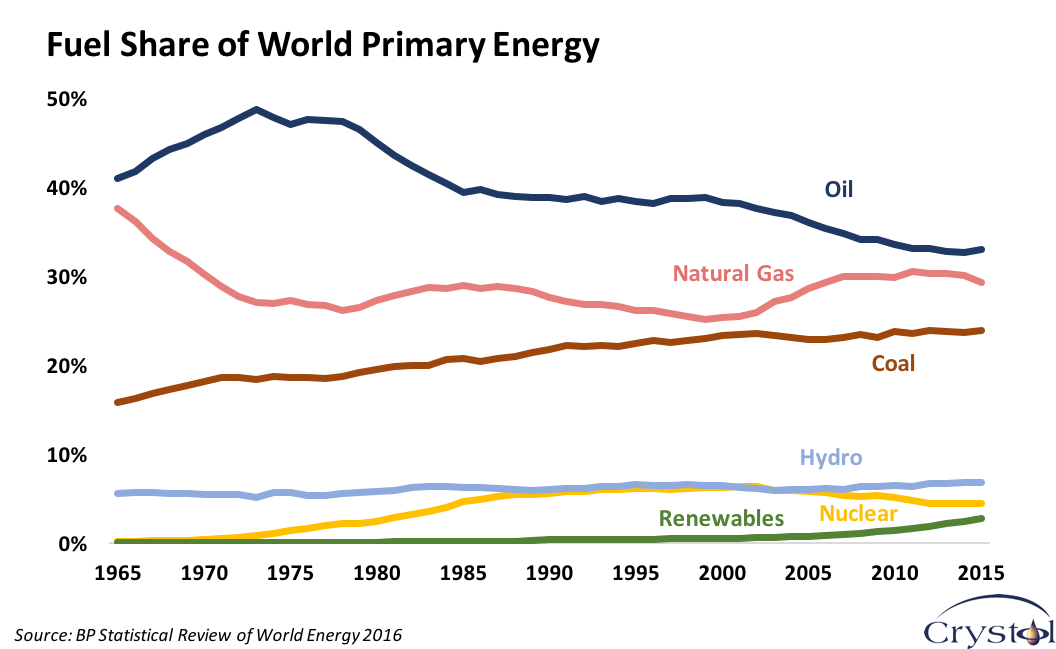Lord Howell
Disruption – driven by ever-newer technology – has become the keyword of the age. Disruption has already played havoc with politics in the West, upending hierarchies, attacking elites and overthrowing established figures and interests. Donald Trump and the British Brexit come to mind, with much more to come in Europe if the anti-EU Marine Le Pen wins the presidency in France, as looks quite likely.
And disruption has long since spread to the entire retailing industry, to transport and taxis, to hotels and holidays, to business models generally – the list goes on and on.
But could revolutionary disruptive influences be about to overturn yet another key area, namely the whole pattern of world energy?
Assumption
The present prevailing assumption, shared by most forecasters, is that while green energy sources – mostly wind and solar – will take a growing share of world power supply, that share will remain modest. Oil, gas and coal will still dominate for years to come. This is because the two natural renewables appear to have two near-fatal flaws – cost and “intermittency”. The sun does not shine everywhere or for 24 hours and the wind does not blow all the time. Expensive backup and standby power has to be kept available, thus inflating costs and reducing reliability. Even when the wind blows it can blow too hard, creating big system destabilization problems in electricity transmission.
In today’s thinking the only longer-term way out of these dilemmas is via vast new nuclear power stations, certainly generating low-carbon electricity but at astronomic construction costs and producing many headaches of waste handling and disposal.
But supposing all that wind and solar power could be cheaply stored, and made available night and day continuously? Costs would plummet, completely undercutting not only nuclear power but other power sources as well. This would be to the delight of the green movement, who never much liked nuclear power anyway.
Disruptive factor
And here comes the disruptive factor. The storage possibilities have suddenly come much nearer than previously imagined. Not only are cheaper, longer-lasting and infinitely cheaper batteries round the corner, but storage in other forms has come within reach. These include turning wind current into ammonia – a simple and cheap process – which can then be stored, transported, broken down into hydrogen and nitrogen or even used as fuel direct for power plants. This “green ammonia” is easy to brew up, can be burned as a fuel in industrial quantities to generate electricity and produces no greenhouse gases whatever.
Economic storage has always been the Holy where to buy accutane online acne.org Grail for renewable power sources. It looks as though the Grail has been found. To give one example of the effects in a U.K. context, a nuclear power plant is now starting to be built that will have to charge around £90 per megawatt/hour for its electricity to make the economics add up.
This is twice as expensive as electricity from burning gas or coal but much cheaper than the other low-carbon sources such as wind, which is estimated to cost much more than £100 from offshore fields. So it has all seemed worthwhile.
But storage technology is about to change that. Suddenly wind could become much cheaper, say £70 a megawatt/hour. The economics of all large nuclear plants are immediately destroyed.
Game Changer
 Here is a game-changer at least on the scale of the shale oil and gas revolution, which has effectively undermined oil markets and halved the oil price. Low-carbon campaigners – which include most governments worldwide – will be hugely pleased to see the market throwing up cheaper green answers without the need for heavy subsidies from the consumer or the taxpayer. In fact, the lukewarm support for nuclear power from the tax-paying public would most likely turn to outright hostility and rejection.
Here is a game-changer at least on the scale of the shale oil and gas revolution, which has effectively undermined oil markets and halved the oil price. Low-carbon campaigners – which include most governments worldwide – will be hugely pleased to see the market throwing up cheaper green answers without the need for heavy subsidies from the consumer or the taxpayer. In fact, the lukewarm support for nuclear power from the tax-paying public would most likely turn to outright hostility and rejection.
What future would be left for nuclear power in this new scenario? The answer is not much – at least not for the behemoth nuclear station designs of yesterday. Nuclear power, too, would have to cut its costs dramatically to stay competitive. This would mean going for much smaller nuclear plants, quicker to build and at a fraction of the capital cost of the old models.
One option would be to construct so-called small modular reactors, fabricating the parts largely inside factories instead of on-site. Another avenue could be micro-nuclear plants with very small waste problems and safe to locate almost anywhere.
But these developments, although being worked on in several countries, are still far from being realized. In the meantime, simple electricity storage methods, capturing nature’s power, are about to arrive.
To this supply revolution has to be added a plethora of new technologies on the demand side for using less power and for using it much more efficiently.
The outcome is quite plain and needs no crystal ball. As in other industries, and as in politics and public affairs, we now have to stand by on the energy front for some real large-scale, mind-shaking disruption and for many long-term plans and projects to be unraveled and replaced.
The article was first published in The Japan Times









